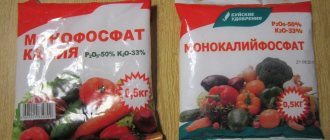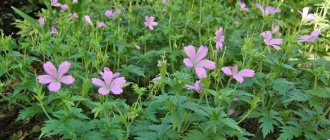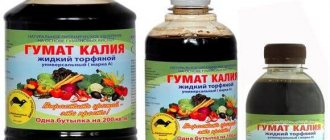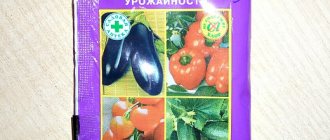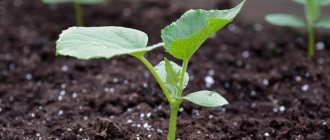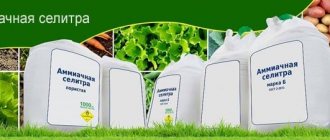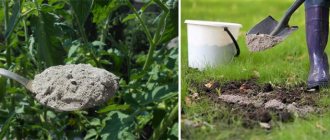Category: Mineral fertilizers Reading time: 7 min · Views: 7,143
Potassium monophosphate is a potassium-phosphorus agrochemical used for gardening and feeding indoor plants. After applying fertilizer, the seedlings begin to bloom wildly and bear large fruits. In addition to feeding plants with micronutrients, potassium monophosphate protects them from pests and fungal damage. The sugar contained in the fertilizer improves the taste of the fruit and increases the shelf life of the crop.
Potassium monophosphate: features of mineral compounds
Potassium monophosphate (MPP) is a ballast-free fertilizer based on a high-percentage potassium-phosphorus concentrate, used to feed plantings. Has the following characteristics:
- chemical formula – KH2PO4 (dihydrogen orthophosphate);
- single crystal density – 2.34 g/cm3;
- water solubility: readily soluble;
- the composition includes the following components: phosphorus – 50–52%; potassium – 33–34%;
Potassium monophosphate (MPP) is a ballast-free fertilizer based on high-percentage potassium-phosphorus concentrate
- release form - 25 kg bag or 500 g plastic bag (sold in a gardening store);
- what they look like: granules or powder of white, beige, slightly brown color.
ATTENTION! Pronounced yellowness in color is evidence of unwanted impurities (defects).
Packing
You can purchase potassium dihydrogen orthophosphate in different packages and packaging. To feed indoor plants, you can use 20 g bags, which Garden-zoo offers to buy - they cost 11 rubles.
To fertilize seedlings and plants in open ground, you will need monophosphate in a larger volume. To do this, you should purchase 0.5 kg packages of monophosphate. Dry fertilizer in powder form weighing 0.5 kg for 230 rubles. can be purchased at the Clean World online store, which sells goods for the garden and garden.
The drug is in the form of granules with a volume of 20 kg for 5 thousand rubles. offers to purchase online store Russia Green. This seller offers discounts for bulk orders.
When choosing packaging volumes, you should proceed from the fact that the dry concentrate cannot be stored for a long time when opened, since it well absorbs moisture contained in the air.
Unopened packages can be stored longer. By correctly calculating the amount of fertilizer needed for the entire season, it is possible to ensure complete feeding of vegetable, garden and ornamental crops with potassium and phosphorus during all periods of the growing season.
Features of the use of superphosphate fertilizers
The product is used for root nutrition or as foliar fertilizer for open and closed soils. Before watering, pre-moisten the soil.
Potassium monophosphate is effective:
- after picking, during transplanting seedlings;
- when feeding decorative plantings during the flowering period, fruit plants - after flowering;
- against powdery mildew (grapes, apples, cucumbers, roses);
- as a component of complex mixtures;
- on medium and small areas with manual processing.
Proper storage
KH2PO4 is best stored in a sealed bag outdoors or in a ventilated room. Monopotassium phosphate should also be kept away from water and light. This is important because it easily absorbs moisture. At the same time, the shelf life of KH2PO4 is not limited.
Advantages of potassium monophosphate
The fertilizer is often used for flowers (flower beds and indoors), vegetables, berries, fruits, because it has many advantages:
- Increases the quantity and quality (sugar content, usefulness, safety) of fruit crops.
- Accelerates the onset of flowering of ornamental seedlings, increases its abundance and duration.
Potassium monophosphate accelerates the onset of flowering of ornamental seedlings
- Protects against fungus (eliminates powdery mildew).
- Promotes the formation of shoots and an increase in their number.
- Increases frost resistance of trees and bushes.
- Chemically pure compound. Does not contain chlorine, sodium, metals. The product does not cause burns to greenery.
- It dissolves in water practically without sediment, hence the high degree and rapid process of assimilation by plants.
- Non-hygroscopic, non-caking.
- It is compatible with almost every pesticide or bait, so it is often used when preparing various nutritional mixtures.
- Moisturizes dry greenhouse soil, allowing you to reduce water consumption in the greenhouse.
- Overfeeding them is almost impossible.
- There are no side effects.
- Does not change soil acidity.
- The high activity of the drug makes it possible to re-feed with nitrogen after waiting from two to five days.
According to consumer reviews, monopotassium phosphate is a very effective remedy.
Stepan, 56 years old:
“I have been using monopotassium phosphate for several years now, growing various crops on the plot with my wife. In the spring, when we plant plants, we fertilize them - in the fall we have as many vegetables as we have never seen before. There are enough reserves for the whole winter. I recommend it to others!”
Fertilizer Potassium Monophosphate
Vasilisa, 35 years old:
“I have been feeding my indoor plants with potassium monophosphate for several years now. Flowers delight the eye with their health, do not get sick, bloom for a long time and are very lush. I like the result."
Expert opinion on potassium monophosphate
Potassium monophosphate is a salt that dissolves over one season. Suitable for feeding all crops during budding and flowering, ovary formation, and when growing vegetable seedlings. Due to its complete, rapid solubility, it is suitable for drip irrigation. Used as an independent fertilizer, in combination with other fertilizers, except magnesium and calcium.
Anatoly Baykov
Precautionary measures
When performing work on feeding plants with this type of fertilizer, you need to wear protective gloves. It should not be allowed to get on the surface of the skin and mucous membranes. When spraying, it is advisable to use a respirator. After completing work, you should immediately wash your hands and wash your face.
According to numerous consumer reviews, the use of potassium monophosphate fertilizer for gardening, vegetable and flower crops does not require much effort, and the result will pleasantly please you. The plant itself will become stronger and greener, and the harvest will be much larger.
If you follow all the rules for using fertilizer, the plants will be healthy. It is important to take into account all the nuances of application, then there will be no problems. And the yield of vegetables, fruits and berries will be much higher than without the use of any fertilizers.
Disadvantages of the product
Of course, there are no ideal drugs. The disadvantages of potassium monophosphate are:
- Quite a high cost.
- It is strongly recommended not to mix the product with magnesium and calcium preparations, which limits its suitability for a number of crops.
- The plant will accept the components of the drug well only in the presence of nitrogen, but it is not recommended to combine monopotassium phosphate with nitrogen mixtures at the same time.
- The active substances of the drug do not accumulate in the soil and quickly disintegrate, so feeding is carried out mainly with solutions. Applying dry fertilizer to the soil does not harm the crops, but it does not provide any benefit either. Therefore, it is almost unsuitable for pre-winter feeding of vegetation.
- Potassium monophosphate is recommended for use in warm seasons in the absence of heat and moderate humidity. In a greenhouse - with regular ventilation and good lighting.
- It has the same effect on weeds as on cultivated vegetation. Use it if you carefully weed your plantings. Untidy summer cottages risk turning into weed jungles.
- The solution is very unstable in air. Use it immediately after preparation.
- May cause excessive tillering (short cuttings), so limit it for flowers grown for bouquets.
- Being a highly active drug, it is unacceptable for potted flowers that develop slowly (succulents, orchids, azaleas, gloxinias, cyclamens).
- It is not the most concentrated potassium-phosphorus fertilizer. Potassium nitrate is superior to it in the first component, superphosphates - in the second.
It has the same effect on weeds as on cultivated vegetation.
There are negative reviews about this product:
Vasily, 55 years old:
I once saw a plot where weeds grew about two meters high. They say that they grow at the expense of the vegetables they are in the neighborhood with. But the owners of the garden bed said that the problem was due to excessive fertilization with potassium monophosphate. It's called "overdoing it"!
Nitrogen Compatible
Potassium monophosphate is compatible with many other mineral and organic fertilizers. This is a universal solution if you need complex treatment of your garden and vegetable garden.
The use of monopotassium phosphate during the growing season to feed plantings is sometimes combined with the addition of nitrogenous mineral compounds. They do not conflict. On the contrary, nitrogen is needed for better absorption of phosphorus and potassium oxide from the soil.
There is just one “but” - they should not be mixed in tank mixtures and added at the same time. A break of at least 3-5 days is necessary. First, the plants are fed with a potassium-phosphorus component, and then with a nitrogen compound.
But monopotassium phosphate is not compatible with calcium and magnesium. The fertilizer must not be mixed with magnesium or calcium nitrate, as well as other fertilizers containing these substances.
Indications for use of fertilizer
The method of application may vary. Let's look at the most popular methods of use.
Watering.
The dosage is 0.1–0.15% (15–20 g of powder per 10 liters of water). Consumption rates for this solution:
- in the first stages of growth of vegetables and ornamental vegetation, 3–5 liters per square meter are consumed. m., and when they have three or four leaves - from five to ten liters;
- fruit trees, bushes - 10–20 liters per sq. m. (concentration can be increased to 30 g);
- greens (parsley, dill, celery) – 2–3 liters per 1 sq. m.
Spraying.
The procedure should be carried out in the evening so that the fertilizer is better absorbed without evaporating under the sun. For ornamental crops, spraying is carried out after a rainstorm. For planned foliar fertilization, the concentration of the solution is 2 g per 10 liters of water.
The procedure is carried out with small sprays until a wet surface film appears on the leaves. Avoid the formation of dripping drops.
Be sure to read the instructions for use inside the package.
Spraying plants
The product is used as a spray:
- under favorable weather conditions;
- for all garden crops;
- for better flowering of decorative flowers;
- for emergency feeding during potassium starvation.
Monopotassium phosphate is a magic powder for the Garden of Eden! Come in, today my flowers are for you!)
Good afternoon to everyone who looked at my garden review! Having a garden with a large number of flowers, I always have the same number of magic bags in stock. Thanks to care and fertilization, my garden smells fragrant from early spring to late autumn! And all I can do is admire and remember to feed my voracious green inhabitants)
The assortment of flowers in my garden is varied, so I also have a lot of bags. The photo shows a small part of my garden first aid kit; I didn’t photograph large packages. And why, if my review is about monopotassium phosphate.
I buy monopotassium phosphate in a 20 gram package. Cost 25-30 rubles.
Phosphorus-potassium water-soluble fertilizer for feeding any crops. The mineral fertilizer is intended for liquid root and foliar feeding of crops in open and protected ground.
All garden crops can be fertilized with monopotassium phosphate.
Roses.
Shrubs.
Phloxes.
I don’t know a garden plant that wouldn’t like this fertilizer! My flowers love, eat and use monopotassium phosphate)))
I buy fertilizer in the form of a water-soluble powder; it dissolves in water almost 100%. I take a lot of packages at once and calculate them and dissolve them in a large barrel. You can feed either by watering or by leaf feeding. I alternate, but after two months of continuous rain the flowers were eating monopotassium on the foliage!
80% of my garden roses bloom profusely and continuously. Of course, I have them not only on a monopotassium diet, but this fertilizer undoubtedly helps a lot to survive the rains.
The garden is healthy, abundant and very, very fragrant!
Monopotassium phosphate is a phosphorus-potassium fertilizer. For seedlings of garden crops in average weather conditions and favorable years. For more abundant flowering, reduced ovary drop and better fruiting - all garden food crops. Ornamental open ground crops - for more abundant and longer flowering. For seasonal outdoor flowers: hanging, potted. For emergency foliar feeding of outdoor and indoor plants in the presence of signs of acute potassium starvation: browned, “rusted,” wrinkled and curled edges of leaves.
I sometimes use monopotassium phosphate in tank mixtures when treating plants against pests. It mixes well with insecticides and pain remedies. Convenient and practical, there is no sediment left in the tank.
My experience of using monopotassium phosphate is only positive, therefore five well-deserved stars and I RECOMMEND!
Special thanks to everyone who completed my review, these roses are for you)
Seedlings, garden and vegetable garden
Let's consider the procedure for applying monopotassium phosphate for various crops.
Consumption rates for primary treatment:
- seedlings of vegetables and flowers - when 2-3 leaves are formed (7-10 g per 10 liters of water);
- vegetables at the beginning of fruiting, when tubers and root vegetables are formed - 7.5–15 g per 10 liters of water);
- fruit and berry trees, ornamental trees, shrubs - after flowering, 10–15 g per bucket of water.
Repeated treatment is carried out with the product in the same dosage. But for seedlings of vegetables and flowers, the event should be carried out two weeks after picking.
Although errors in the concentration of the feed are not serious, the correct dose will give maximum results.
Treatment of tomato seedlings with monopotassium phosphate
Instructions for treating individual plants with monopotassium phosphate:
For tomatoes.
Water the crop 2 times per season with an interval of 2 (3 in a good year) weeks. The concentration of the working solution is 0.15%. Consumption – a bucket for four bushes. In the intervals between scheduled watering of tomatoes, it is recommended to spray the leaves with a 0.02% solution.
Processing cucumbers.
Water the cucumbers on a schedule similar to the previous one. Use spraying, but correlate foliar feeding with the development of cucumbers (an alarming signal is a curved or pear-shaped fruit). If the shape of the cucumbers is not pleasing, and there is a week left before watering, then it is better to carry out a foliar procedure. In this case, postpone the next feeding, keeping an interval of 1.5–2 weeks.
Root vegetables, onions and garlic.
Feed potatoes only by treating the leaves so as not to harm the tubers. The rate of potassium monophosphate is from 0.02 to 0.05%, the number of applications is twice in one season. Bulb crops and other root crops are fed in the same way.
Feeding fruit and berry plants.
Fruit-bearing trees, bushes, and berries are cared for by watering. The concentration of the solution is 0.2%. You can water in the morning if there is no fog or rain and the soil is not dry. Unscheduled treatments on the crown should be carried out in productive years and after heavy rains. Only the green parts are sprayed (most of the solution is sprayed on the underside of the leaves).
Fertilizing strawberries with fertilizer
Russian manufacturers
Where in our country can you purchase the above-described preparation for fertilizing plants? Russia is represented in the world by a number of large companies and factories that produce chemical mineral fertilizers, in particular KH2PO4. Among them:
- .
- LLC NVP "BashInkom"
- LLC "Modern Quality Technologies"
- .
- Group .
- LLC "DianAgro"
- .
- .
- .
Thus, there are many enterprises in Russia that produce this popular fertilizer on an industrial scale.
The packaging of KH2PO4 at the above-described production facilities is different - from 20 to 500 grams. In addition, these can be whole bags of twenty-five kilograms. It all depends on the needs of the consumer.
Monopotassium phosphate and flowers
Fertilizer for flowers is used when the buds begin to bloom or if they have fully blossomed. If the year is favorable, water the seedlings with a solution at a concentration of 0.1%, the consumption rate is 3–4 l/sq.m. m.
Having noticed 3-4 formed leaves on the flowers, so that flowering occurs earlier, spray with a solution of 0.02%.
Outdoor flowerpots and hanging flowers are fed in the same way as ground plantings.
Potassium monophosphate is suitable for most flowering plants: petunias, tulips, phlox, roses.
How to make fertilizing with your own hands
Sometimes buying the drug in stores may seem too expensive. In this case, you can prepare KH2PO4 for feeding plants with your own hands.
For this you need the following components:
- Phosphoric acid, which can be found in anti-rust products and toilet cleaners.
- Ash from burning wood, which contains potassium carbonate.
To properly prepare the fertilizer yourself, you will need:
- Fill a half-liter jar of ash to the top.
- Pour the ash into a container with a capacity of up to two liters.
- Pour the ash with one liter of warm water and mix everything thoroughly.
- Leave the mixture to steep for several hours.
- Pour the solution without stirring the sediment into a three-liter container.
- Carefully add phosphoric acid in small doses. Bubbles will actively appear on the surface.
- Shake the mixture while adding phosphoric acid.
- Add acid until no more bubbles of carbon dioxide are released.
Working solution of fertilizing:
- Pour one glass of mother liquor into a bucket.
- Add ten liters of settled water.
- Mix everything thoroughly.
Reviews
- Valentina Alexandrovna (Samara).
Previously, potassium monophosphate was used for tomatoes. One day I decided to feed an orchid that had not bloomed for a long time. I was pleasantly surprised when a flower arrow appeared. Since then I have been watering orchids before and during flowering.
- Ekaterina Konstantinovna (St. Petersburg).
Through trial and error, I came to the conclusion that it is better to use potassium monophosphate on its own and not mix it with other fertilizers. Then you won’t have to doubt whether they are compatible or not.
Returning to the land is a great indicator that people care about their health. But active work with the soil, namely, dense planting of all crops, leads to soil depletion. It's unavoidable. Provided that the farmer does not carry out proper comprehensive applications.
Potassium monophosphate is a substance that will restore the soil in a short time. An additional advantage of the drug is that it can be used as a prophylactic agent.
But before you start applying, you need to make sure that the monophosphate will not cause damage to the crops. There are also features that are not taken into account in the recommendation note on use.
